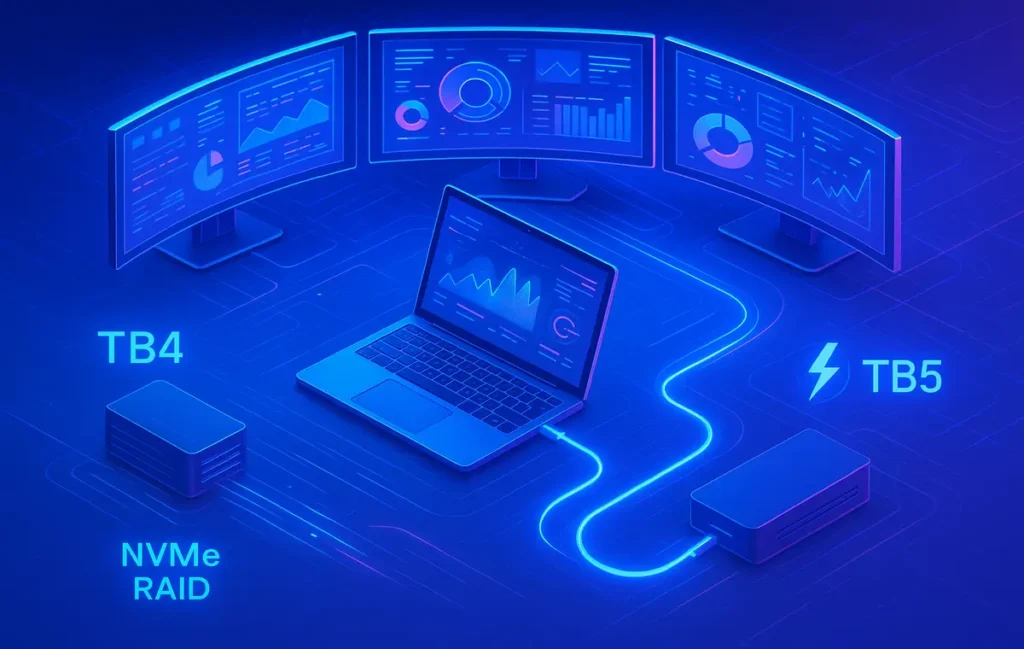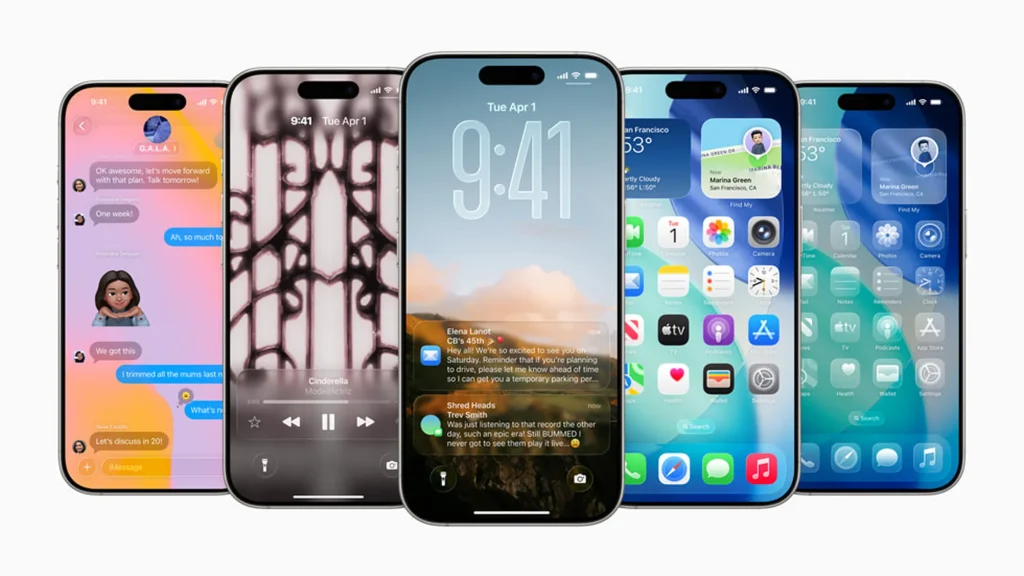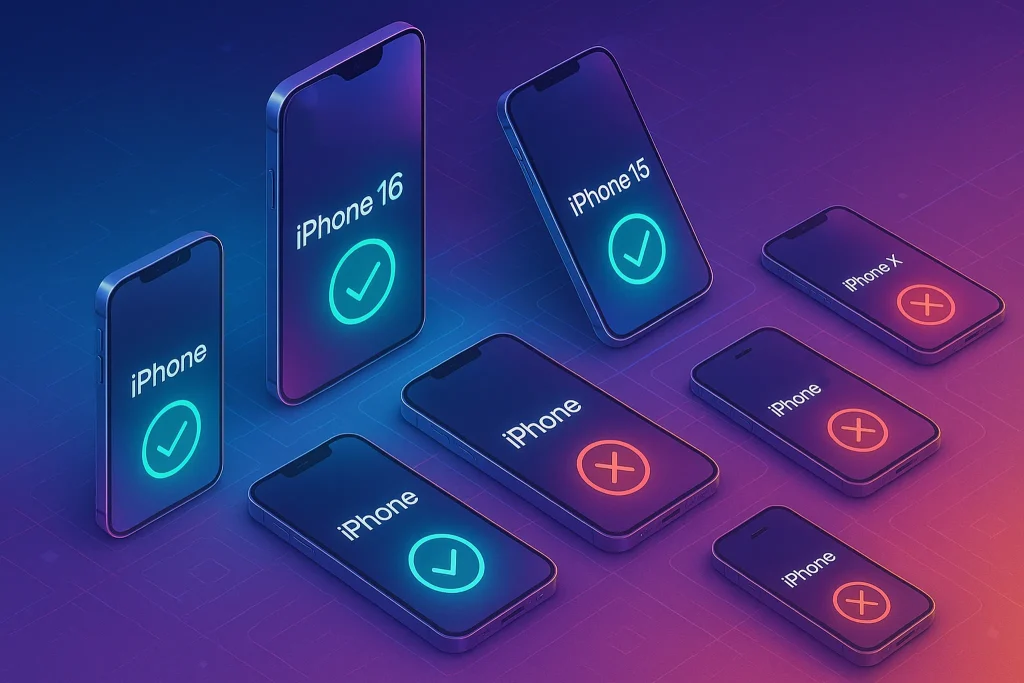🔌 Intro
Thunderbolt has always been the frontier of high-speed connectivity on laptops and compact desktops. It’s the one cable that promises power, display, storage, and networking without turning your desk into a spaghetti bowl. With Thunderbolt 5 now rolling out, the obvious question is: what’s different from Thunderbolt 4—and should you pay for it? In this in-depth NerdChips guide, we’ll break down the real gains in bandwidth, display support, power delivery, and PCIe tunneling; map who benefits (and who won’t yet); and help you decide if Thunderbolt 5 belongs in your next machine.
Along the way, we’ll connect the dots to related deep dives—like USB4 v2.0 & DisplayPort 2.1 and monitors such as the LG UltraFine Evo 6K Monitor with Thunderbolt 5—so you can see how the ecosystem is evolving for creators, gamers, and AI PC buyers.
💡 Nerd Tip: Thunderbolt specs tell only half the story. Real-world speed depends on the slowest link in your chain—drive speeds, cables, dock chipsets, and GPU display engines all matter.
🧭 Thunderbolt 4 Recap (Why It’s Still So Good)
Before we jump to the new stuff, it’s worth remembering why Thunderbolt 4 became the safe default for premium laptops and docks. TB4 standardized what TB3 made optional. That meant predictable minimums across devices and fewer surprises when you plugged into a random dock.
At a practical level, Thunderbolt 4 = 40 Gbps aggregated bandwidth, with tunneling for PCIe, DisplayPort 1.4 (with DSC), and USB. It typically supports two 4K displays at 60 Hz or a single 8K (with DSC), and it leans on USB Power Delivery (USB PD) for charging—commonly up to 100 W on laptops and up to 15 W to power bus-powered accessories. For creators and power users, TB4 also brought reliable wake-from-sleep experiences and mandatory support for 32 Gbps PCIe tunneling (roughly PCIe 3.0 x4), which is why high-end external SSDs and 10/25 GbE adapters “just work.”
In short, TB4 remains rock-solid for dual-monitor productivity, fast external SSDs (~2.8–3.2 GB/s in real life), and single-cable laptop docking. For many users, it’s still overkill.
⚡ Thunderbolt 5: What’s Actually New
Thunderbolt 5 is a step-change rather than a baby step. The headline upgrade is bandwidth. Baseline aggregated bandwidth jumps to 80 Gbps (bi-directional), and with Bandwidth Boost the link can dynamically reallocate lanes to deliver up to 120 Gbps in one direction (usually from computer to display) while maintaining 40 Gbps back. That matters most when you’re pushing multiple high-refresh, high-resolution displays and moving data simultaneously.
Another pillar is DisplayPort 2.1 tunneling. Compared to TB4’s DP 1.4 era, DP 2.1 raises the ceiling for resolution and refresh, especially when paired with DSC (Display Stream Compression). In practical topologies, TB5 can comfortably drive triple 4K high-refresh or dual 6K (think: that LG UltraFine Evo 6K) from a single cable when your GPU supports it, with room left for storage and networking. For single-panel fans, 8K at higher refresh (commonly 60–120 Hz with DSC) is squarely in scope depending on the monitor’s link rate and the GPU’s capabilities.
The third major change is more headroom for power. TB5 rides the USB PD 3.1 Extended Power Range wave, which means charging up to 240 W is possible when both device and EPR-rated cable support it. It’s not guaranteed on every TB5 port, but the ceiling is much higher than TB4’s common 100 W.
Finally, PCIe tunneling bandwidth gets a meaningful boost: TB4’s 32 Gbps ceiling becomes up to 64 Gbps on TB5. That’s a big deal for external NVMe RAID arrays, capture cards, multi-port 10/25 GbE NICs in docks, and experimental eGPU setups.
💡 Nerd Tip: Don’t assume “TB5 = 120 Gbps all the time.” Bandwidth Boost is dynamic and workload-dependent. Think of it like a smart traffic system that opens extra lanes when your displays need it.
🆚 Side-by-Side: TB4 vs TB5 (The Useful Bits)
| Feature | Thunderbolt 4 | Thunderbolt 5 |
|---|---|---|
| Aggregated Bandwidth | 40 Gbps | 80 Gbps (bi-directional) |
| Peak One-Way Boost | — | Up to 120 Gbps (Bandwidth Boost) |
| PCIe Tunneling (peak) | ~32 Gbps | Up to ~64 Gbps |
| Display Tunneling | DP 1.4 (DSC) | DP 2.1 (DSC) |
| Typical Displays | Up to dual 4K60 or 8K60 (DSC) | Triple 4K high-refresh or dual 6K; 8K at higher refresh with DSC, GPU-dependent |
| Power Delivery (Charging) | Commonly up to 100 W (USB PD) | Up to 240 W possible with USB PD 3.1 EPR & certified cables |
| Cables | Passive 0.8 m @ 40 Gbps or active longer | New TB5 active cables for full speed; backward compatible |
| Compatibility | USB4/TB3 backward compatible | Backward compatible with TB4/TB3/USB4 |
| Best For | Reliable pro docks, dual 4K, fast SSDs | Multi-display creatives, AI PCs, external RAID, higher-end gaming/graphics |
Numbers reflect protocol ceilings; actual results vary with devices, GPUs, docks, and cables.
🖥️ Displays & Creators: Where TB5 Changes the Game
If you live in color-accurate timelines, multi-cam edits, or heavy compositor graphs, TB5’s DP 2.1 tunneling and Bandwidth Boost are the stars. Moving from TB4 to TB5 is like going from a two-lane highway to a four-lane with a reversible express lane when traffic spikes.
What you can expect in real workflows:
-
Triple-monitor 4K setups at high refresh for timeline + scopes + reference display, without sacrificing high-speed storage bandwidth.
-
Dual 6K workflows, which finally make sense if you’ve been eyeing panels like the LG UltraFine Evo 6K Monitor with Thunderbolt 5 for a clean single-cable desk.
-
Stable screen sharing & capture while driving those displays, because PCIe tunneling headroom rises to ~64 Gbps—handy for external capture cards and multi-port networking.
Pair TB5 with a fast external RAID and you’ll see another tangible bump: TB4 often tops out around ~2.8–3.2 GB/s on single-drive enclosures; TB5 RAID arrays can push 5–7 GB/s in real-world tests with multiple NVMe drives and a good controller. That’s not a synthetic brag; it cuts export times and shortens relink/reconform waits.
💡 Nerd Tip: If you’re shopping for a creator laptop or AI PC, balance the TB5 port with a GPU that supports DP 2.1 features. The link can carry it—but your GPU has to generate it.
🎮 Gamers & eGPU Curious: Does TB5 Move the Needle?
For gamers, TB5’s appeal splits in two: displays and external graphics.
On displays, multi-monitor high-refresh 4K becomes far more feasible from a single port, assuming the GPU can supply it. That’s great for sim rigs or content-creator-gamers who want a high-refresh gameplay monitor plus two auxiliary panels for chat, music, or streaming tools. If you’re exploring OLED, scope our Best OLED Monitors in 2025 Reviewed to understand pixel response, panel types, and burn-in mitigations in a TB5 context.
On eGPU, TB5’s ~64 Gbps PCIe tunneling is a meaningful jump over TB4’s ~32 Gbps. It doesn’t magically turn a laptop into a desktop with a full x16 slot, but GPU utilization improves and CPU-to-GPU transfer bottlenecks reduce, especially at 1440p/4K where the GPU is the limiter. If you run external storage and eGPU and multiple displays through the same cable, TB5’s traffic shaping helps you avoid those “why did my FPS drop when I hit record?” moments.
If you’re pushing huge game libraries over external drives, also check Best External SSDs for Gaming—TB5 RAID boxes with Gen4 NVMe can load worlds and textures faster than TB4 equivalents, shaving real time off level loads and asset streaming.
💡 Nerd Tip: For competitive FPS, the biggest “feel” win is still refresh rate and input latency. If your TB5 budget competes with a great 240–360 Hz display, the monitor might deliver more joy per dollar.
🤖 AI PCs, USB4 v2.0 & the Ecosystem Story
Thunderbolt 5 doesn’t exist in a vacuum. It’s arriving alongside AI PCs with dedicated NPUs and GPUs built to accelerate local models. That matters because moving tensors between GPU, NPU, and storage en masse benefits from more PCIe tunneling headroom and higher-bandwidth links to external accelerators and arrays. If you’re building mixed workflows (video + local AI + vector DB on an external SSD), TB5 feels less like a luxury and more like an enabling layer.
There’s also a standards angle. TB5 co-evolves with USB4 v2.0 & DisplayPort 2.1. USB4 v2.0 promises 80 Gbps as well, and DP 2.1 is the display lingua franca for next-gen panels. The value of TB5 is not just raw speed; it’s the predictable, certified end-to-end experience across docks, cables, and devices that creators and IT teams count on.
Finally, TB5 dovetails with next-gen displays. If you’re eyeing a 6K or 8K panel, or multiple 4K high-refresh screens, TB5’s Bandwidth Boost unlocks topologies TB4 struggled with. That’s why the latest 6K monitors are launching with TB5 upstreams.
💡 Nerd Tip: Buying a 2025 laptop? Cross-check the NPU class and TB5 support. If your work mixes local AI with heavy I/O (RAIDs, capture, multi-display), those two specs will age well together.
Also see: Laptops & Desktops with Neural Engines Onboard for a buyer’s map.
🧪 Real-World Numbers: What You’ll Likely See
Specs are ceilings; let’s set expectations grounded in typical gear:
-
External SSD/RAID throughput: TB4 single-drive enclosures commonly land around 2.8–3.2 GB/s. TB5 multi-NVMe RAID enclosures can realistically hit 5–7 GB/s sustained with good controllers and cooling.
-
Display mixes: TB4 can do dual 4K60 reliably; triple displays often require compromises. TB5 can handle triple 4K high-refresh (DSC) or dual 6K more gracefully, while keeping enough bandwidth for fast storage.
-
Charging: Many TB4 docks deliver 90–100 W. TB5 devices may offer 140–240 W charge options with USB PD 3.1 EPR and certified EPR cables. Not every TB5 port will do 240 W—verify the laptop/dock spec sheet.
-
Cables: Your trusty TB4 0.8 m cable will work on TB5 but at TB4 speeds. For full TB5 performance (80/120 Gbps), you’ll need TB5-certified active cables.
💡 Nerd Tip: Heat kills performance. If your TB5 RAID’s speed fades during long copies, add airflow. Many “mystery slowdowns” are thermal throttling in cheap NVMe enclosures.
🧩 Who Should Upgrade (Now vs Later)
Creators with multi-display + fast storage needs will feel TB5 immediately. Colorists, VFX, and editors who keep two or three 4K panels active while reading/writing multi-GB/s media will appreciate the headroom and stability.
Gamers and streamer-creators benefit if they’re building complex multi-monitor battlestations or planning external high-speed storage for massive libraries. Pure competitive gamers on a single high-refresh 1440p display won’t need TB5 right away.
AI PC buyers running local LLMs or video-to-AI workflows (think: upscaling, background removal, vector search on external drives) are prime candidates—TB5 can shorten I/O bottlenecks in mixed pipelines.
Everyday users who dock a laptop to one or two 4K screens, browse, and do office work can happily stay on TB4 for another cycle. It’s already great.
🧱 Adoption, Cables & Docks: Practical Buying Notes
Early TB5 devices are hitting premium laptops and creator desktops first, with broader mid-range adoption trailing by a year. Expect AI PC-branded Windows laptops to lead; macOS timelines depend on Apple’s rollouts.
On docks, TB5 models command a price premium because they pack pricier retimers, controllers, and often better power stages. If your daily needs map to TB4, a quality TB4 dock is still the sweet spot on value. If you’re moving to dual 6K or triple 4K, shop TB5.
On cables, buy once, cry never:
-
For TB5 peak modes and higher PD, choose TB5-certified active cables and USB PD 3.1 EPR-rated when charging >100 W.
-
Label your cables. Mixing passive TB4, active TB4, and TB5 cables without tracking which is which is a surefire way to wonder why one port “seems slower.”
💡 Nerd Tip: Dock chipset matters. A great TB5 dock pairs PCIe bandwidth smartly with USB4 lanes and DP 2.1. If you run into odd display limits, update the dock firmware—vendors quietly ship fixes.
🧠 Decision Helper: TB4 or TB5 for Your Use Case?
Use Case: Dual 4K productivity + one fast SSD
TB4 is perfect. Save your budget for a better panel or SSD. See Best OLED Monitors in 2025 Reviewed for where to spend the difference.
Use Case: Triple 4K creator desk + 5–7 GB/s external RAID
TB5 earns its keep. Pair it with a DP 2.1-capable GPU and a TB5 dock that advertises triple-4K support.
Use Case: AI PC with local models + external vector DB + capture
TB5 reduces I/O bottlenecks when everything is busy at once. Combine with a high-class NPU. Read Laptops & Desktops with Neural Engines Onboard.
Use Case: Single 1440p/240 Hz competitive gaming
TB4 is fine. Spend on CPU clocks, GPU, and the monitor itself.
Use Case: External GPU experiments
TB5’s higher PCIe tunneling helps; still expect some overhead vs an internal x16 slot.
🎨 Quick Checklist (Upgrade Readiness)
-
Do you need more than two 4K displays or dual 6K?
-
Do your workflows demand >3 GB/s sustained external storage?
-
Will you charge at >100 W from a dock or cable regularly?
-
Are you building an AI PC with heavy local model use?
-
Do you require single-cable simplicity under load (display + storage + capture)?
If you hit 3+ yes answers, TB5 will likely pay back in time saved and clutter avoided.
⚡ Ready to Go Beyond Dual 4K?
Explore Thunderbolt 5 docks, certified active cables, and NVMe RAID enclosures that unlock triple-4K and 5–7 GB/s external storage—no desk clutter.
🧪 Implementation Mini-Playbook: Upgrading the Right Way
If you’re migrating from TB4 to TB5, treat it as a system change, not just a port upgrade.
Start with your bottleneck map. Are you display-bound (not enough lanes for triple 4K), I/O-bound (external storage peaking at ~3 GB/s), or power-bound (your dock can’t keep a 16-inch laptop charged under render load)? That answer decides where TB5 pays off first.
Next, assemble a clean chain: TB5 host → TB5-certified cable → TB5 dock or TB5 drive enclosure → modern DP 2.1 displays and/or Gen4 NVMe RAID. Avoid mixing legacy DP hubs or marginal adapters that down-shift the whole link.
Finally, validate under load: run a timeline export or a game session while copying to external storage and streaming. You’re looking for stability, thermals, and whether your OS power profile needs tuning to keep the TB5 controller in its higher performance states.
💡 Nerd Tip: Use a monitoring overlay to watch link speed and device temps while testing. If a single NVMe runs at 90°C in a fanless enclosure, TB5 can’t save you from physics.
🧯 Challenges & Adoption Curve (What to Expect in 2025–2026)
Cost & availability: Early TB5 docks and cables carry premiums. Availability improves over the next 12–18 months, and prices follow.
Cable confusion: Expect a transitional period where visually similar cables have wildly different capabilities (TB4 passive vs TB5 active vs USB4 v2.0). Label yours.
Device variance: Not every TB5 laptop exposes the same power or display capabilities. Some will prioritize charging wattage; others will lean into triple-display topologies. Read the spec sheet carefully.
Apple & TB5: macOS timelines may lag certain Windows AI PCs. If you’re in Apple’s ecosystem, evaluate your display plan first; TB4 on Apple Silicon already punches above its weight for many 4K workflows.
Gaming reality check: eGPU gains are real but not magical. TB5 makes better eGPU possible; it doesn’t erase the value of a desktop PCIe slot for pure performance chasers.
📬 Want More Smart Connectivity Breakdowns?
Join our free newsletter and get weekly deep dives on AI PCs, display tech, and creator hardware—straight to your inbox. No fluff. Just practical guidance from NerdChips.
🔐 100% privacy. No noise. Just value-packed hardware & workflow tips.
🧠 Nerd Verdict
Thunderbolt 5 isn’t just a spec bump; it’s a workflow enabler. The jump to 80 Gbps with a 120 Gbps boost lane, DP 2.1, and higher PCIe tunneling reshapes what a single cable can reliably do—especially for creators running triple 4K or dual 6K desk setups while hitting external arrays at >5 GB/s. It also future-proofs AI PC workloads where large models, fast scratch space, and multi-display rigs collide.
For everyday users, Thunderbolt 4 remains excellent and budget-smart. For gamers with simple single-monitor rigs, spend on the GPU and panel first. But if your desk is a cockpit—and your time is money—TB5 is the most meaningful interconnect upgrade since TB3.
❓ FAQ: Nerds Ask, We Answer
💬 Would You Bite?
If you were buying today, would you choose a slightly cheaper TB4 laptop and a better monitor, or go TB5 to unlock triple 4K and faster external storage? Tell us your setup and we’ll help you spec the chain.
Crafted by NerdChips for creators and teams who want their best ideas to travel the world.



